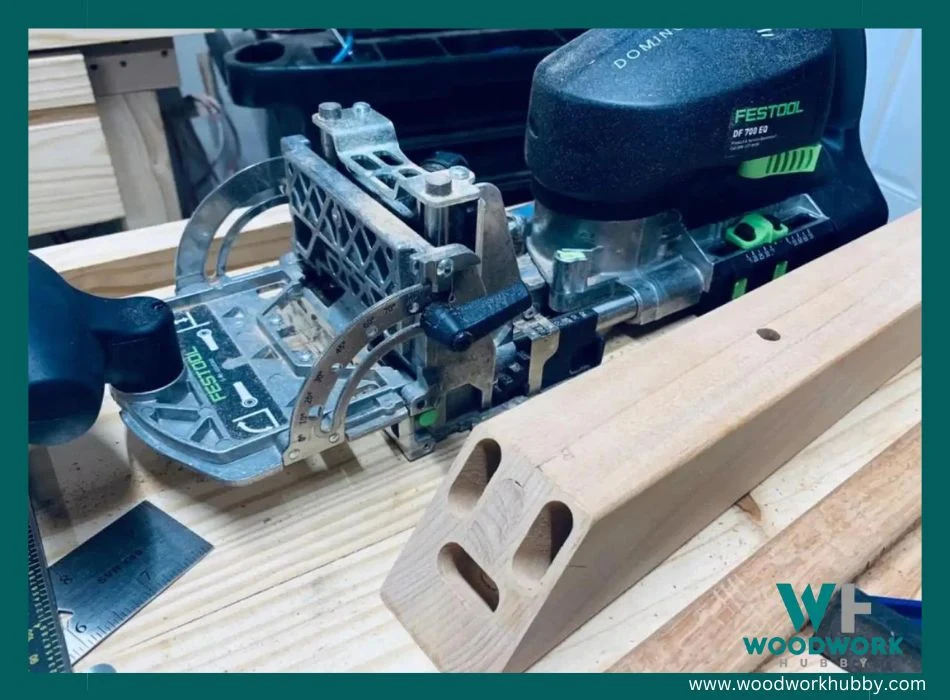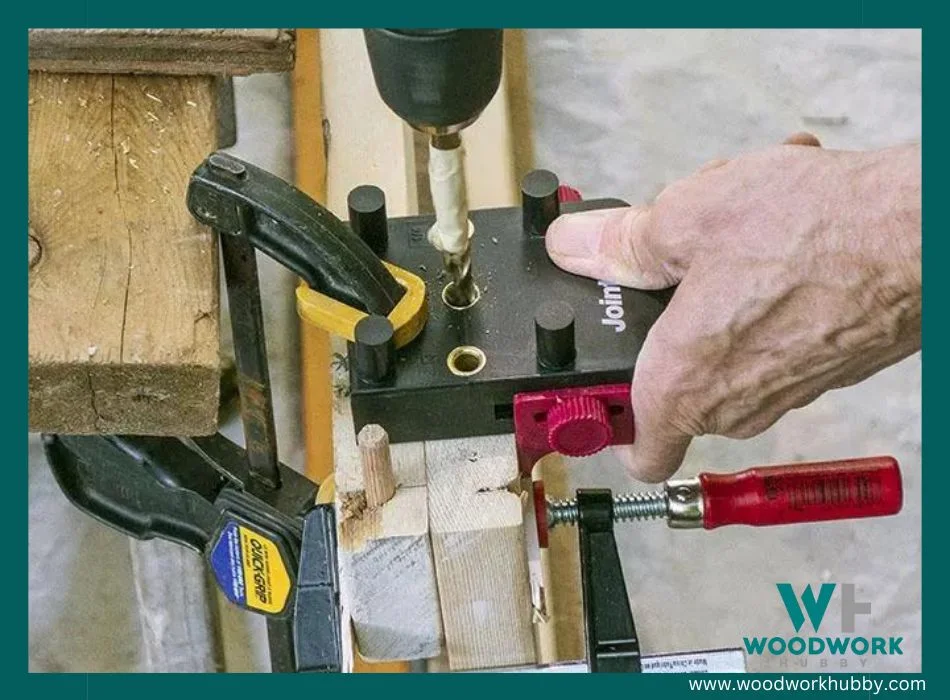If you have been watching YouTube videos to discover woodworking ideas or to learn how to build specific projects, you might have seen a domino joiner. Most top woodworking YouTubers use it instead of dowels but which should you use in the battle of the domino joiner vs. dowels?
A Domino Joiner is quicker and more precise than a doweling jig and Dominoes are stronger than dowel tenons. However, the 50x to 100x price difference between a domino joiner and a doweling jig makes the latter more appropriate for hobbyists.
In this article, you will learn how a domino joiner fares against a doweling jig. You will discover the comparative strength of both the joints and whether there is a project quality difference if you choose one over the other.
By the end of this post, you will know which one is ideal for you. But first, I’ll go over a brief definition of both to set a foundation.
| Aspect | Domino | Dowel |
|---|---|---|
| Shape | Rounded mortise | Blunt pin |
| Price per tenon | $0.07 | $0.03 |
| Joiner/Jig Price | $1,090+ | Under $50 |
| Joint strength | Higher Per Unit | Lower Pet Unit |
| Mode of use | Beginner-friendly | Expert |
| Greatest advantage | Saves time | Saves money |
| Greatest disadvantage | Is expensive | Requires expertise |
Dominoes and Dowels: What Are They?

A domino is a floating mortise joint with rounded corners. It can also be seen as a thick biscuit joint. It is created and patented by Festool. A dowel is a cylindrical pin joint invented in 690 AD. With these definitions out of the way, let’s compare the two.
Are Dominoes Stronger Than Dowels?
A single domino is stronger than a single dowel in most cases. However, you can use multiple dowels to create a joint much stronger than the average domino. Domino Joiner’s selling point isn’t its strength but its effortless precision and time-saving.
In most cases where you would choose between a dowel or a domino, the strength of the joints isn’t the greatest concern. Since domino joints replace dowels, they need to be at least as strong as dowels, which they are.
See what I wrote about when does the domino patent expire and is it time for a competitor?
Both dowels and dominoes can be used for tables, chairs, and cabinetry. Unless two pieces of wood are actively being torn apart, dominos and dowels have functionally the same value.
But a domino joiner and a doweling jig do not have the same value. Doweling jigs require more practice and are harder to use. A domino joiner is a much more beginner-friendly tool. Ironically, it is not priced for beginners and is most often used by professional woodworkers.
Why Is a Domino Better Than a Dowel?
A single domino is better than a single dowel because a dowel is thinner. A domino is a cross between a dowel and a mortise joint. It can be seen as an elongated dowel, which has understandably higher strength. A woodworker needs fewer dominoes, which reduces the time it takes to finish a project.

While a single domino beats a single dowel, you don’t usually use one of each in every context. 2 dowels can be stronger than a single domino. Similarly, deep dowels can beat shallow dominoes in a stress test. The answer isn’t as black and white as the manufacturers of domino joiners would want it to be.
But when it comes to ease and time-saving, dominos seem to universally outperform dowel jigs and joiners in general. Even people who claim that they can dowel just as fast lag behind. This aspect might not mean much to hobbyists. But for professionals whose time is money, it is very important to save time.
I have been into woodworking for over 20 years and can estimate earnings by glancing at a project. In my experience, a Domino joiner pays for itself if you consider the time saved in making just one hardwood table.
The price of the joiner can be covered by the time saved in making prestige furniture. But how many woodworkers are making prestige furniture for sale? Not as many are making cabinets and shelves for personal use. So a domino would be a splurge for a hobbyist and a reasonable purchase for an intermediate woodworker.
Which Is Stronger, Dowel or Biscuit Joint?

A biscuit has a larger surface and is hence stronger than a dowel joint. However, it is possible to use biscuits poorly since they work in specific applications. Outside of their appropriate setting, they can prove weaker than dominoes. Dowels, on the other hand, can be used in most joints.
Biscuits Beat Dowels in Ease of Fashioning
If you’re looking up dowels vs. dominoes because dowels are hard to craft, you might find biscuits really valuable. Biscuits are much easier to fashion compared to dowels, which makes them woodworkers’ go-to joints wherever biscuit joinery makes sense.
Dowels Beat Biscuits in Versatility
While biscuits are stronger and easier to make, they don’t fit all joints. Dowels seem to have a monopoly on versatility. Dowels can be used in places where mortise joints and biscuits make sense.
They can even be used in place of dovetail joints, albeit to a poor effect. The relatively small size of dowels also makes room for multiple joints in a small area, which can improve the joint’s stress resistance. Biscuits, on the other hand, are limited to flat joint applications.
Biscuits Beat Dowels in Strength
In most cases, biscuits are stronger than dowel joints of equal depth. It must be noted that this comparison is of single units. Generally, multiple dowels can be used to outperform a single biscuit, domino, or mortise. Deeper dowels can also outperform shallower biscuit or mortise joints.
A video testing the strength of biscuits, dowels, and dominos.
Are Domino Joints Strong?
Domino joints are used in place of dowels and are strong enough to replace them. They can be seen as rounded mortise joints or thicker biscuit joints. Given that mortise units and biscuits are stronger than dowels, it would not be unfair to say that dominos joints are strong.
That said, you must consider the factors that affect a domino’s strength.
- Joint thickness – The thicker a joint, the stronger it is. Dominoes are thicker than dowels and are relatively stable.
- Joint depth – Longer dominoes have higher joint strength than shorter dominoes.
- The elasticity of the wood – While domino tenons are pretty strong, the wood around them is a major dictator in the overall joint strength. If the wood doesn’t grip the domino with enough strength, the joint can fall apart.
- The type of load – Finally, the type of load dictates whether or not a domino joint can survive. When a joint is under constant pressure perpendicular to the tenon, it can persevere. But the same pressure pulling the tenon back can lead to the joint failing.
Meanwhile, if you’re wondering about the strength of a pocket hole joint, you may want to read this article for more info.
Price Differences for Dominoe and Dowels
If you’re about to choose between dowels and dominoes, you have to contend with the price differences between the joiners and tenons of each type. In both cases, dowels are significantly cheaper.
A Dominoe Joiner like DF 500 costs almost $1100. The most adopted domino joiner (DF 700) costs nearly $1600. In contrast, low-end doweling jigs like MilesCraft Joint Mate costs $9.65 to $10.77.
With the jig/joiners out of the way, let’s look at the tenon prices. Milescraft Dowel Pin bucket with 375 tenons costs $9.99. In contrast, Festool 300 Domino Set costs $27.
Please remember that more dowels are used instead of dominos. But even if you divide the price of Dominos by half, it is still higher than that of dowels.
Final Thoughts – Domino Joiner vs Dowels – Which Is Best for You
Dowels are stronger than dominoes but not enough to justify the price difference, especially in the jigs. The only time a domino joiner makes sense is if you can save enough time with the joiner to make another project that pays for the price difference.
But since most hobbyists are generally not selling at price points that produce said difference, dominoes are best left for advanced professionals.









